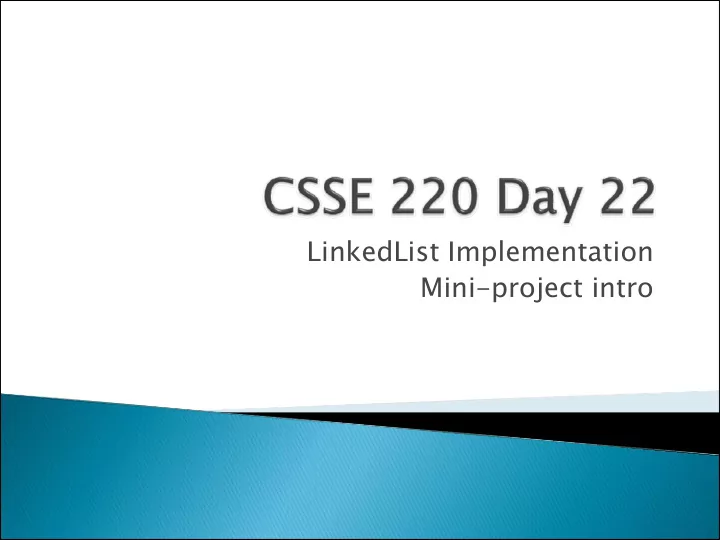

LinkedList Implementation Mini-project intro
� Turn in your written problems � Mini-project Partner Survey: Do it by 4:00 today � Reminder: Exam #2 is this Thursday ◦ In order to reduce time pressure, you optionally may take the non-programming part 7:10-7:50 AM. ◦ You may bring one piece of paper with notes for the first part. ◦ Same resources as last time for the programming part. � Markov Milestone 2 due Friday ◦ http://svn.cs.rose-hulman.edu/repos/220-200820-markovXX � where XX is your 2-digit team number. � Take the Markov Justification quiz on ANGEL now (5 minutes)
� Answers to your questions in preparation for the exam � Some (not-so stupid) Minesweeper tricks. � A look at my Hardy solution � Empirical analysis of an algorithm. � More on Linked Lists (if we don't finish today)
� Will be done by teams of 3, Weeks 9-10 � I will pick teams, based on performance of students in the class so far. ◦ Rationale for putting people with similar performance together � There is a survey on ANGEL that lets you tell me the names of up to two people whom you'd prefer NOT to work with. � Project will be a spell-checker and suggester � Other projects have been highly-specified. For this one, you have a lot of leeway and can be very creative.
� GUI-based program � Check the words of a text file for spelling ◦ User can browse to file � Flag words that are not in program's dictionary � Suggest possible alternate spellings ◦ Think of ways misspelling can occur: � missing or added letters � transposed letters � no space between words � things you come up with � An interface that allows user to correct the spelling. ◦ change, ignore, ignore all, …
� Some GUI things you'll want to learn how to do ◦ Browse to a file and open it ◦ Deal with text in a text box ◦ Display a list of choices and get user selection � Some things you can do before Monday's kick-off. ◦ Look for a dictionary to use (share it!) ◦ Look at user interfaces of some spell-checkers ◦ Look up various Java classes that may be useful � Especially helpful: The Java Swing book from Safari Tech Books online (see course syllabus)
� Now. Look for a dictionary, think about the kinds of spelling errors you want to detect/correct. � Day 25. Begin working with your partners. � Day 27. Demonstrate some progress in class. � Day 30. Final submission of the project is due.
� Abstract Data Types and Data Structures � Collections and Lists � Markov � Thursday's Exam � Material you have read � Anything else
� LinkedList Implementation
� Stores items (non-contiguously) in nodes; each contains a reference to the next node. � Lookup by index is linear time (worst, average). � Insertion or removal is constant time once we have found the location. ◦ show how to insert A4 after A1. � If Comparable list items are kept in sorted order, finding an item still takes linear time.
� What is the main cause? ◦ All nodes of the linked list are pointed to by the next next field of the previous ListNode … ◦ … except the first node, which is pointed to by the first first field of the LinkedList object. � One solution: ◦ Add an extra node at the beginning of the list ◦ The "header" node. ◦ So a list of n items is represented by n+1 nodes. ◦ The first element of the list is in the second node.
� Change the code to include this node. � last should point to the last node. � Write remove remove and iterator iterator .
class LinkedList implements List { ListNode first; ListNode last; Constructors: (a) default (b) single element. Attempt these in the Attempt these in the methods: order shown here. order shown here. public boolean add(Object o) Appends the specified element to the end of this list (returns true ) public int size() Returns the number of elements in this list. adds o at index i. public void add(int i, Object o) throws IndexOutOfBoundsException public boolean contains(Object o) Returns true if this list contains the specified element. (2 versions). public boolean remove(Object o) Removes the first occurrence (in this list) of the specified element. public Iterator iterator() Can we also write listIterator( ) ? Returns an iterator over the elements in this list in proper sequence.
class ListNode{ Object element; // contents of this node ListNode next; // link to next node ListNode (Object element, How to implement ListNode next) { LinkedList? this.element = element; fields? this.next = next; } Constructors? Methods? ListNode (Object element) { this(element, null); } ListNode () { this(null); } }
� More specifically, what is a j ava.util.Iterator ? ◦ It's an interface: ◦ interface java.util.Iterator<E> ◦ with the following methods: An extension, ListIterator , adds:
� Each node has two pointers, prev prev and next next. � There is one other new node, tail tail, whose prev prev pointer points to the node containing the last element of the list. � This makes remove() easier to write ◦ and it also makes an efficient ListIterator ListIterator possible.
Recommend
More recommend